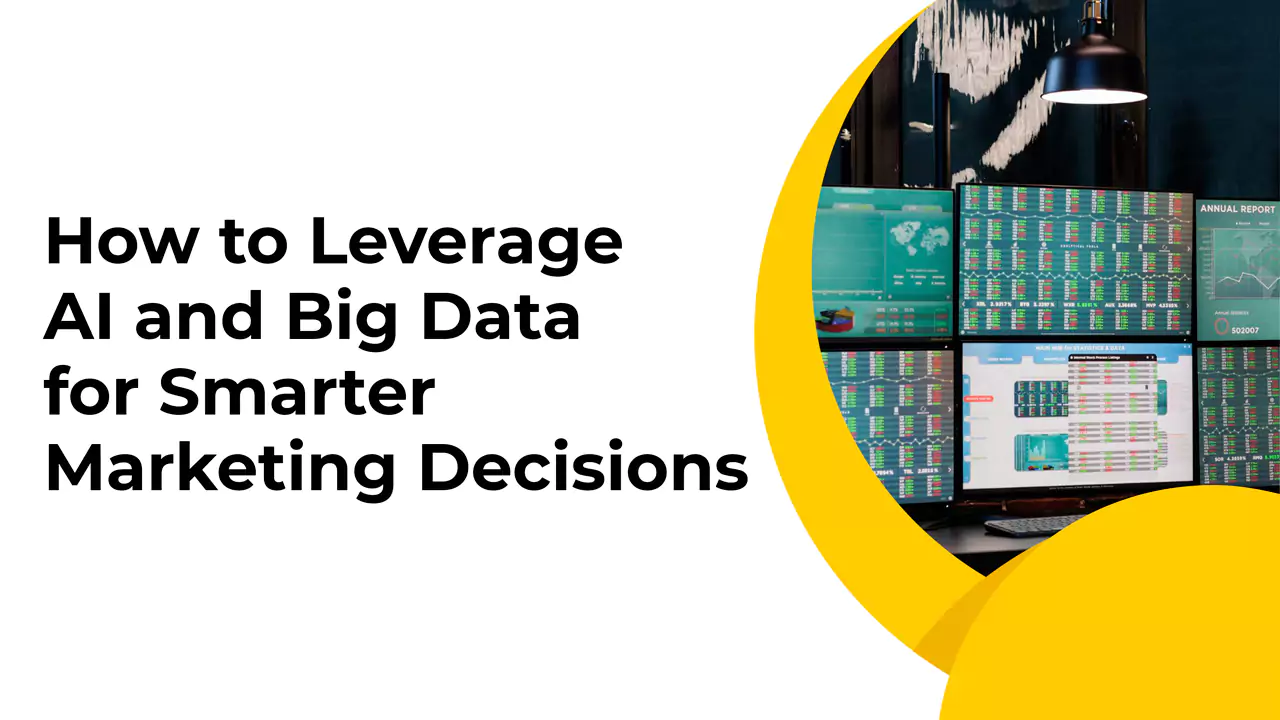How to Leverage AI and Big Data for Smarter Marketing Decisions
Table of Contents
- Big Data for Big Marketing Decisions: How It Works
- AI and Big Data in Marketing
- Benefits of Using AI and Big Data for Marketing
- Smarter customer insights
- Hyper-personalization
- Better ROI through optimized advertisement strategy
- Real-time decision-making and automation
- Dynamic pricing
- Inventory and supply chain adjustments
- Customer support routing
- Instant campaign optimization
- Improved customer journeys through predictive recommendations
- Practical Use
- Getting Started: A Step-by-Step Guide
- 1. Audit data and tools you’re currently using
- 2. Set clear marketing goals
- 3. Choose the right platforms/tools
- 4. Train your team
- 5. Start small, scale up
- Privacy Concerns to Consider
- Conclusion
Description: Informed decisions work wonders for business development and the more data is available to make them the better. Big data processing provides great assistance for improving modern marketing strategies and boosting sales.
Big Data for Big Marketing Decisions: How It Works
The current state of marketing is very challenging. Any strategy will likely require multiple adjustments as things change fast and the sooner you recognize them as a constant the better. What can be done to stay ahead with your marketing decisions and how do consider all the necessary metrics to ensure the efficiency of your efforts?
Artificial Intelligence (AI) and big data are the best bets for staying afloat with all the evolution the marketing field undergoes nowadays. They can help brands better understand their audience and craft new strategies.

In the context of marketing, Big Data refers to the enormous volume of information generated every second from multiple sources—customer interactions, social media platforms, website analytics, purchase histories, mobile apps, and more. This data is not only vast in quantity but also diverse in format (texts, clicks, videos, locations) and generated at high speed. Without proper tools, it’s impossible to process or draw insights from it manually.
That’s where AI comes in. AI technologies such as machine learning, natural language processing, and predictive analytics are capable of analyzing massive datasets in real time. They detect patterns, identify trends, and even anticipate future behaviors. In the hands of marketers, this means moving from intuition-based strategies to data-driven campaigns that adapt and improve continuously.
Together, AI and big data make marketing more personalized and efficient. Marketers no longer need to guess what customers want; they can know it, and deliver the right message at the right time, through the right channel.
This article will explore how businesses can actually use these tools for better decisions.
AI and Big Data in Marketing
Big data collects information through a customer data platform and AI further uses it to detect patterns and craft insights. Think of big data as the food market and AI as the seasoned cook able to work wonders with given ingredients. Each is impressively efficient itself but together, they create smarter, faster, and more effective marketing decisions.
The massive amounts of raw information are collected from various sources including customer behavior, web analytics, social media interactions, purchase history, etc. It’s rich with potential insights but difficult to process and make sense of without help. AI works with this raw data, finds trends, makes predictions, and even automates responses. It turns messy, overwhelming amounts of information into clear insights marketers can further act on.
For example, big data can tell you how many people visited your site last week, but AI can analyze who they were, what they looked at, why they left, and when they’re most likely to return. Then it can help tailor a campaign specifically targeting those behaviors. That’s how they complement each other: one gathers the pieces, the other puts the puzzle together and decides what to do next.
Benefits of Using AI and Big Data for Marketing
Such powerful tools can surely help any business perform better. There’s no need to guess which products or updates will sell better, data analysis provides specific answers by processing current user behavior. Let’s see how these insights benefit the business.
Smarter customer insights
Marketers can use behavioral patterns and sentiment analysis to assess customer experience correctly. With a better understanding of what your clients are looking for and their attitude towards your offer or product, it is easy to see what can be improved.

Hyper-personalization
The advanced form of personalization goes beyond just using a client’s name in an email. Hyper-personalization uses real-time data, AI, and big data analytics to tailor content, product suggestions, and marketing messages to individual users based on their specific behaviors, preferences, and needs. And now, they are capable of doing this at scale! It’s not just for 10 VIP customers anymore; it’s done for thousands or even millions of users simultaneously using automation tools powered by AI.
Better ROI through optimized advertisement strategy
It is possible to significantly improve your budgeting for advertisements as now marketers can use big data and AI to make smarter decisions like where to spend your ad budget most effectively. It is possible to identify audiences that are most likely to convert, what channels they use, and what messages resonate with them. This means marketers don’t waste money showing ads to people who aren’t interested.
Real-time decision-making and automation
How it works:
Dynamic pricing
Prices can be adjusted in real time based on demand, competitor activity, time of day, or customer behavior. Airlines, hotels, ride-shares, and even retail platforms use this to maximize profit while staying competitive.
Inventory and supply chain adjustments
If AI sees a spike in demand (like searches or purchases), it can trigger alerts or automatic restocking processes, ensuring products are available where they’re needed most, reducing missed opportunities.
Customer support routing
AI can monitor incoming customer queries and route them to the right team instantly or provide immediate chatbot responses. Faster resolution contributes to customer satisfaction.
Instant campaign optimization
AI can analyze how a campaign is performing in real time and tweak it reallocating budget, changing messaging, or even pausing ineffective channels.
Improved customer journeys through predictive recommendations
Big data and AI not only provide you with information you may not know about your clients, but they can predict what offer will be met with interest and likely sell. Even more, AI also models user behavior to predict their next move. Not just what they like, but what they’re likely to do next. Then it helps guide them toward a purchase or support.
Practical Use
How AI and big data can be integrated into day-to-day marketing tasks? From refining customer segmentation to automating communication with virtual assistants, the following examples demonstrate the true potential of these tools in reshaping marketing strategies, enhancing customer engagement, and optimizing business outcomes.
- Dynamic customer segmentation based on behavior and demographics.
- Predictive analytics used for forecasting trends or product success.
- AI-powered chatbots and virtual assistants to decrease the response time and improve customer experience.
- Content strategy development using AI tools that suggest or generate content ideas based on performance data.
There are likely more ways in which big data and AI can help marketers make their efforts pay off. From regular task automation to composing thorough and insightful reports, AI boosts the efficiency of performance which contributes to business growth.
Getting Started: A Step-by-Step Guide
How do you start to implement such power tools into your daily operations? Follow these steps to make the process as smooth as possible:
1. Audit data and tools you’re currently using
Before implementing AI and big data-driven marketing strategies, it’s crucial to assess your current data usage. This includes reviewing the types of data you have, where it’s stored, and how it’s being processed. Are you gathering enough customer data? Are your analytics tools providing the insights you need? By auditing your data, you can identify any gaps in information that could hinder your efforts. This also includes evaluating the effectiveness of current marketing platforms.
2. Set clear marketing goals
AI and big data can provide you with powerful insights, but it’s essential to align them with specific, measurable business objectives. Whether your goal is to improve customer retention, boost sales, enhance personalized marketing efforts, or streamline customer service, defining clear marketing goals helps you prioritize what you need to improve.
3. Choose the right platforms/tools
Once you’ve outlined your objectives, selecting the right platforms and tools is key to successfully implementing AI and big data. Choosing the right tool requires understanding what each platform offers and matching it with your team’s skill set and business needs. Don’t just focus on features; consider factors like ease of use, scalability, and integration with existing systems.
4. Train your team
AI and big data are specialized fields, and having the right expertise in-house is vital to success. Depending on your team’s current skill set, you might need to invest in training or hire new talent who are proficient in data science, machine learning, and AI applications. Training existing employees ensures they can use new tools effectively, while hiring professionals with specialized skills may be necessary if you lack expertise in these areas.

5. Start small, scale up
AI and big data-driven marketing initiatives can seem overwhelming, so it’s important to start small. Begin by applying AI to one aspect of your marketing strategy (customer segmentation or personalized email campaigns) and see how it performs. This allows you to test your strategies, understand what works, and make adjustments without risking large amounts of time and money. Once you’ve seen positive results, you can begin scaling up, and applying these solutions to other areas of your marketing endeavors. Our business plan writers can help you integrate AI and big data insights into your marketing plan.
Privacy Concerns to Consider
While personalization and data-driven marketing have brought remarkable efficiency, there’s a fine line between relevance and overreach. Today’s consumers are increasingly aware of (and often uneasy about) how their data is used. It’s easy to overdo with personalization to the extent that people feel like they are the product, which can through a shadow on a brand they used to love. Smart marketing isn’t just about anticipating behavior to drive conversions; it’s about building trust. The most effective strategies in the long run are those that prioritize transparency and respect. Rather than pushing for one more click, aim to create experiences that make people want to stay.
Conclusion
As businesses adopt AI and big data, the ability to make smarter, faster, and more targeted marketing decisions becomes not just possible, but essential. These technologies offer valuable insights, improve customer experiences, and help companies stay competitive. However, it’s equally important to prioritize the ethical use of data, respecting user privacy, maintaining transparency, and avoiding manipulative practices. Trust is a vital currency, and responsible data usage is key to sustaining it.

